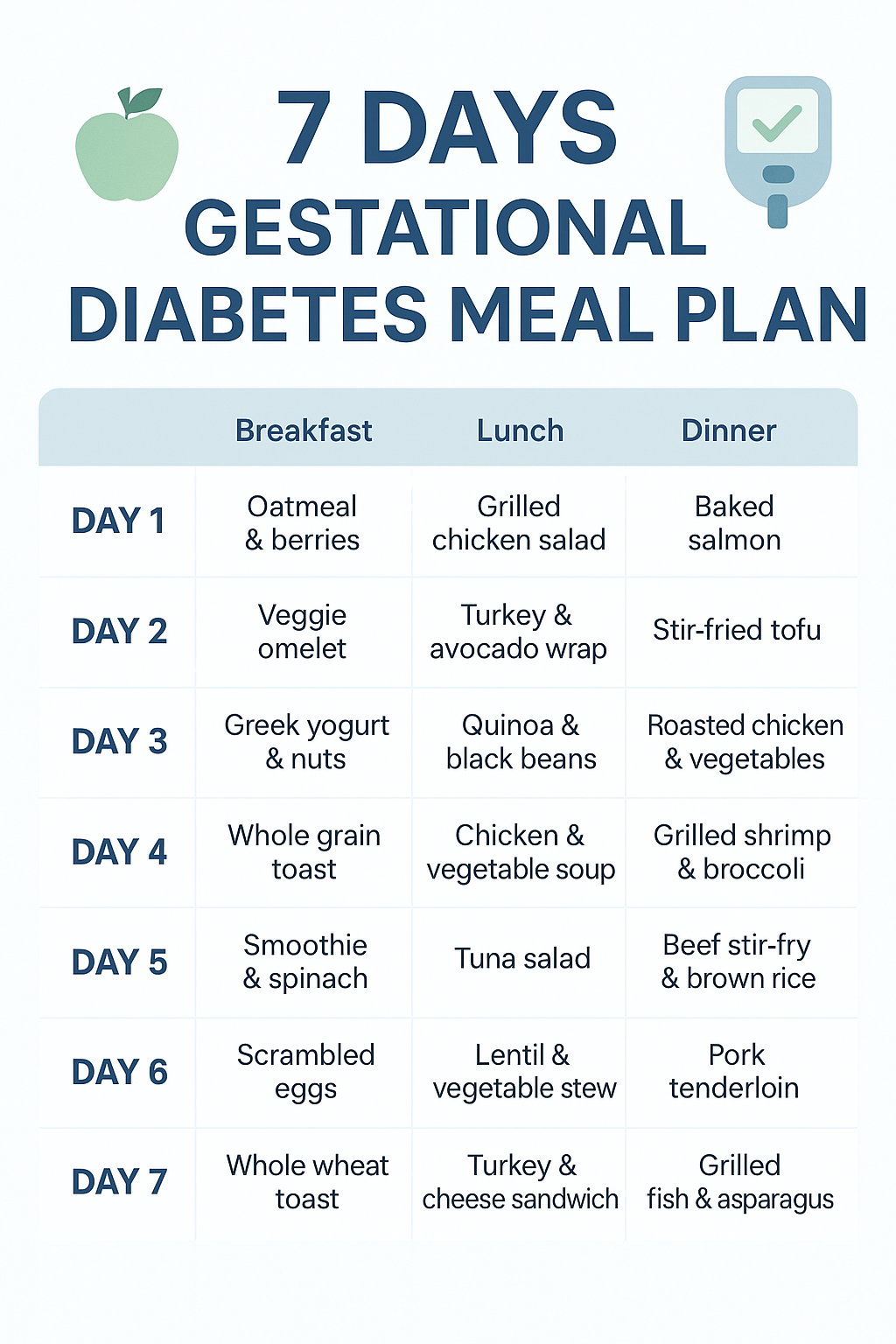Gestational Diabetes (GD) occurs when the body’s insulin response to hormonal changes is diminished, leading to elevated blood sugar levels during pregnancy. It might go against the ear, but the thing is that with conscious eating and frequent physical activity, positive results can be achieved, and the blood glucose level will be under control, and the baby and the expectant mother will be healthy.
This gestational diabetes meal plan is a 7-day plan that involves a balanced diet: moderate carbohydrates, lean protein, healthy fats, and high fibre. The meals are made to maintain blood sugar levels, help avoid energy crashes, and support the development of your baby.
Considerable Pre-Filming Guidelines
- Eat the right amount of carbohydrates: Divide carbohydrates and eat in moderation during the day, rather than eating a lot of carbohydrates at a time.
- Select complicated carbs: Whole grains, beans, lentils, fruits, and vegetables are sources of fibre that slow down the absorption of glucose.
- Combine carbs with protein or fats: This will help avoid blood sugar spikes.
- Keep yourself hydrated: Take 8-10 glasses of water a day.
- It is important to avoid sugary drinks: to exclude soda, fruit juices, and desserts prepared with refined sugar.
- Snack smartly: Smaller, regular meals are good at avoiding hypoglycaemia and hyperglycaemia.

7 Days Gestational Diabetes Meal Plan
Day 1
Breakfast:
- 1 slice of whole-grain toast with 1 boiled egg and slices of avocado.
- 1 small apple
- 1 cup unsweetened green tea
Mid-Morning Snack:
- A handful (10–12) of almonds
Lunch:
- Grilled chicken breast (100g)
- ½ cup brown rice
- Green salad (spinach, cucumber, tomatoes, olive oil dressing)
Evening Snack:
- 1 single serving of Greek yoghurt (unsweetened) and a sprinkle of chia seeds.
Dinner:
- Carrot and spinach Lentil soup.
- 1 small whole-wheat chapati
- Side of cucumber slices
Day 2
Breakfast:
- Vegetable omelette (1 egg + 1 egg white and bell pepper, tomato, onion)
- 1 slice brown bread
- ½ cup milk (low-fat, unsweetened)
Mid-Morning Snack:
- 1 pear
Lunch:
- Lemon and herbs baked fish.
- ½ cup quinoa
- Broccoli and carrots cooked in steam.
Evening Snack:
- Roasted chickpeas (handful)
Dinner:
- Paneer or tofu salad that is grilled, accompanied by lettuce, tomato, cucumber and olive oil.
- 1 small bowl of mixed fruit (apple + papaya)
Day 3
Breakfast:
- Oatmeal cooked in water with a tablespoon of milk and walnuts and cinnamon on top.
- 1 boiled egg
Mid-Morning Snack:
- Cucumber sticks with hummus
Lunch:
- Stir-fry chicken and vegetables (mashed in olive oil)
- ½ cup brown rice
Evening Snack:
- 1 small orange
Dinner:
- Moong dal (divided green gram soup)
- 1 multigrain chapati
- Sauteed spinach.
Day 4
Breakfast:
- Greek yogurt parfait: takes the form of yogurt with strawberries and 2 tablespoons of oats.
- 1 boiled egg
Mid-Morning Snack:
- Handful of peanuts
Lunch:
- Lentil and vegetable curry
- 1 bowl brown rice or 1 chapati.
- Salad (cucumber, carrots, lettuce)
Evening Snack:
- 1 small apple or pear
Dinner:
- Grilled chicken kebabs
- Steamed mixed vegetables
- ½ small baked sweet potato
.
Day 5
Breakfast:
- 1 paratha made of whole-wheat and cooked in olive oil, with low-fat yogurt.
- ½ banana
Mid-Morning Snack:
- 1 tsp. mixed nuts (almonds, walnuts, pistachios)
Lunch:
- Brown rice, pea, and carrot vegetable pulao.
- Cucumber raita
Evening Snack:
1 piece of full-grain crackers with cheese.
Dinner:
- Grilled salmon (or other fish)
- Stir-fried vegetables (broccoli, beans, bell pepper)
- 1 small chapati
Day 6
Breakfast:
- 1 boiled egg
Mid-Morning Snack:
- 1 orange
Lunch:
- Vegetable curry and chickpea.
- 1 chapati or ½ cup brown rice
Evening Snack:
- Small handful of makhana (fox nuts) that have been roasted.
Dinner:
- Paneer fried cubes with stir-fry vegetables.
- Lentil soup
Day 7
Breakfast:
- Whole-wheat toast and scrambled egg and tomato.
- 1 small apple
Mid-Morning Snack:
- Yogurt with flaxseeds
Lunch:
- Salad composed of mixed beans (kidney beans, black beans, and chickpeas)
- Minimal amount of chicken or tofu that is grilled.
Evening Snack:
- Small portion of nuts or roasted grams.
Dinner:
- Moong dal vegetable soup
- 1 small multigrain chapati
- Cucumber-tomato salad
Notable Nutritional Information
1. Carbohydrate Management
The carbohydrates in every meal ought to be 30-45 grams and snacks 15-20. Dwelling on low glycemic index (GI) carbs include whole grains, beans, lentils, fruits such as apples, pears and citrus.
2. Protein Power
Don’t skip out on any meal without a source of protein eggs, chicken, fish, paneer, yogurt, or lentils. Protein is useful in maintaining the level of blood sugar and in the development of the baby.
3. Healthy Fats
Nuts, seeds, olive oil and fish have monounsaturated and polyunsaturated fats that ensure hormonal balance and insulin resistance is avoided.
4. Fiber-Rich Foods
Eat fibre at all meals to reduce the rate of digestion and glucose excretion. Eat refined carbs instead of brown rice, oats, beans and vegetables.
5. Hydration
Preferred are water, herbal teas and milk. Energy drinks and sweet juices are to be avoided. Dehydration may have an effect of raising blood sugar.
Foods to Limit or Avoid
| Avoid | Reason |
| Refined flour, white rice, white bread | High GI, spikes blood sugar |
| Sugary snacks, sweets, cakes | High in simple sugars |
| Fruit juices and soft drinks | Concentrated sugars |
| Fried foods, trans fats | Enhance insulin resistance |
| Foods that are processed and packaged. | Large quantities of sodium and preservatives |
| Food Group | Portion Size |
| Whole grains | carbs 1/2 cup bread, cooked or 1 slice. |
| Protein 100g | chicken/fish or 50g beans. |
| Vegetables | 1 -2 cups (cooked or raw) |
Gestational Diabetes Lifestyle Management Tips
- Break Up Every 3-4 hours: Continuous eating averts sugar lows and highs.
- Include physical activity: 20 to 30 minutes of walking post-meal decreases post-meal glucose.
- Check blood sugar: Check fasting and post-meal sugar levels as recommended by your physician.
- Sleep and stress control: Lack of sleep and stress increases blood sugar- attempt relaxation methods.
- Follow-ups: Make follow-ups with your medical team to adjust medications or insulin.
Conclusion
Controlling gestational diabetes requires making more intelligent, well-balanced decisions rather than giving up delicious food. This seven-day meal plan provides wholesome, useful meals that promote your baby’s growth and stabilise blood sugar. For optimal effects, combine it with regular glucose monitoring, hydration, and moderate exercise.
Frequently Asked Questions
1. Is it possible to eat fruits with gestational diabetes?
Yes, but select low-GI fruits such as apples, pears, oranges or berries. Do not have huge amounts or fruit juices.
2. Which snacks have the most blood sugar control?
Good options include nuts, yoghurt, boiled eggs, roasted chickpeas or whole-grain crackers with cheese.
3. What is the number of calories that I should consume every day?
The normal calorie requirement of most pregnant women with GD is 1,800-2,200 kcal/day, although your doctor or dietician might increase or decrease this amount depending on weight, activity, and trimester.
4. Is fasting safe?
Missing meals will lead to hypoglycaemia (low blood sugar). Consume small and balanced meals all throughout the day.
5. Does gestational diabetes disappear after childbirth?
Yes, blood sugar tends to level after delivery, although eating healthy habits prevents type 2 diabetes in the future.

 Medically reviewed by
Medically reviewed by